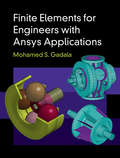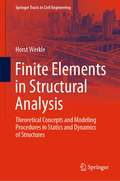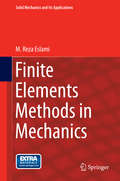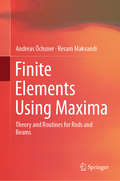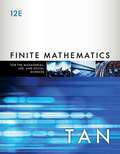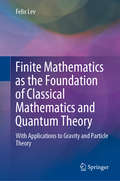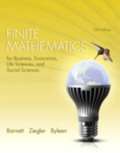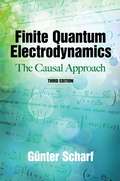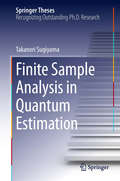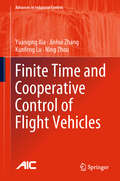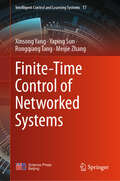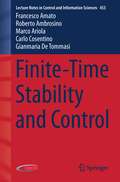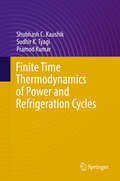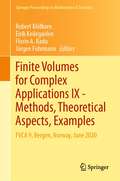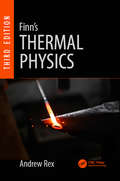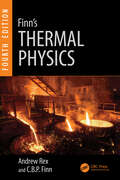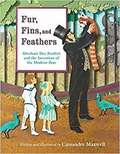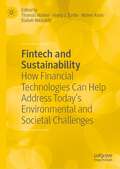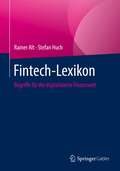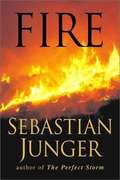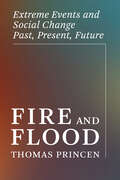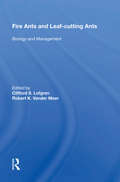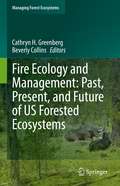- Table View
- List View
Finite Elements for Engineers with ANSYS Applications
by Mohamed GadalaThe finite element method (FEM) is indispensable in modeling and simulation in various engineering and physical systems, including structural analysis, stress, strain, fluid mechanics, heat transfer, dynamics, eigenproblems, design optimization, sound propagation, electromagnetics, and coupled field problems. This textbook integrates basic theory with real-life, design-oriented problems using ANSYS, the most commonly used computational software in the field. For students as well as practicing engineers and designers, each chapter is highly illustrated and presented in a step-by-step manner. Fundamental concepts are presented in detail with reference to easy to understand worked examples that clearly introduce the method before progressing to more advanced content. Included are step-by-step solutions for project type problems using modelling software, special chapters for modelling and the use of ANSYS and Workbench programs, and extensive sets of problems and projects round out each chapter.
Finite Elements in Structural Analysis: Theoretical Concepts and Modeling Procedures in Statics and Dynamics of Structures (Springer Tracts in Civil Engineering)
by Horst WerkleThe book introduces the basic concepts of the finite element method in the static and dynamic analysis of beam, plate, shell and solid structures, discussing how the method works, the characteristics of a finite element approximation and how to avoid the pitfalls of finite element modeling. Presenting the finite element theory as simply as possible, the book allows readers to gain the knowledge required when applying powerful FEA software tools. Further, it describes modeling procedures, especially for reinforced concrete structures, as well as structural dynamics methods, with a particular focus on the seismic analysis of buildings, and explores the modeling of dynamic systems. Featuring numerous illustrative examples, the book allows readers to easily grasp the fundamentals of the finite element theory and to apply the finite element method proficiently.
Finite Elements Methods in Mechanics
by M. Reza EslamiThis book covers all basic areas of mechanical engineering, such as fluid mechanics, heat conduction, beams and elasticity with detailed derivations for the mass, stiffness and force matrices. It is especially designed to give physical feeling to the reader for finite element approximation by the introduction of finite elements to the elevation of elastic membrane. A detailed treatment of computer methods with numerical examples are provided. In the fluid mechanics chapter, the conventional and vorticity transport formulations for viscous incompressible fluid flow with discussion on the method of solution are presented. The variational and Galerkin formulations of the heat conduction, beams and elasticity problems are also discussed in detail. Three computer codes are provided to solve the elastic membrane problem. One of them solves the Poisson's equation. The second computer program handles the two dimensional elasticity problems and the third one presents the three dimensional transient heat conduction problems. The programs are written in C++ environment.
Finite Elements Using Maxima: Theory and Routines for Rods and Beams
by Andreas Öchsner Resam MakvandiThis book provides a study aid on the finite element method. Based on the free computer algebra system “Maxima”, it presents routines to symbolically or numerically solve problems in the context of plane truss and frame structures. This allows readers to not only check classical “hand calculations” but also understand the computer implementation of the method. The mechanical theories focus on the classical one-dimensional structural elements, i.e. bars, Euler–Bernoulli and Timoshenko beams as well as their combination to generalized beam elements. Focusing on one-dimensional elements reduces the complexity of the mathematical framework and the resulting matrix equations can still be displayed with all components, and not only in a symbolic representation. The use of a computer algebra system and the incorporated functions, e.g. for equation solving, highlights the methodology of the finite element method rather than standard procedures.The book is based on the Springer Brief “Finite Elements for Truss and Frame Structures” (978-3-319-94940-6) by the same authors.
Finite Mathematics: For The Managerial, Life, And Social Sciences
by Soo T. TanFINITE MATHEMATICS FOR THE MANAGERIAL, LIFE, AND SOCIAL SCIENCES, Twelfth Edition, is a clear, easy-to-follow text that balances contemporary mathematics applications and the latest technology to help give you the key problem-solving skills you need for your life and career in the 21st century. Real-world applications put math concepts in context and cover topics including social media accounts, corporate fraud, criminal justice, cyber privacy, starting a new job, gas prices, smartphone ownership, mobile ad revenues, and more.
Finite Mathematics as the Foundation of Classical Mathematics and Quantum Theory: With Applications to Gravity and Particle Theory
by Felix LevThis book delves into finite mathematics and its application in physics, particularly quantum theory. It is shown that quantum theory based on finite mathematics is more general than standard quantum theory, whilst finite mathematics is itself more general than standard mathematics.As a consequence, the mathematics describing nature at the most fundamental level involves only a finite number of numbers while the notions of limit, infinite/infinitesimal and continuity are needed only in calculations that describe nature approximately. It is also shown that the concepts of particle and antiparticle are likewise approximate notions, valid only in special situations, and that the electric charge and baryon- and lepton quantum numbers can be only approximately conserved.
Finite Mathematics for Business, Economics, Life Sciences, and Social Sciences (Thirteenth Edition)
by Raymond A. Barnett Michael R. Ziegler Karl E. ByleenLearn about the math that will help you in many careers and academic disciplines.
Finite Quantum Electrodynamics: The Causal Approach, Third Edition (Dover Books on Physics)
by Gunter ScharfIn this classic text for advanced undergraduates and graduate students of physics, author Günter Scharf carefully analyzes the role of causality in quantum electrodynamics. His approach offers full proofs and detailed calculations of scattering processes in a mathematically rigorous manner. This third edition contains Scharf's revisions and corrections plus a brief new Epilogue on gauge invariance of quantum electrodynamics to all orders. The book begins with Dirac's theory, followed by the quantum theory of free fields and causal perturbation theory, a powerful method that avoids ultraviolet divergences and solves the infrared problem by means of the adiabatic limit. Successive chapters explore properties of the S-matrix -- such as renormalizability, gauge invariance, and unitarity -- the renormalization group, and interactive fields. Additional topics include electromagnetic couplings and the extension of the methods to non-abelian gauge theories. Each chapter is supplemented with problems, and four appendixes conclude the text.
Finite Sample Analysis in Quantum Estimation
by Takanori SugiyamaIn this thesis, the author explains the background of problems in quantum estimation, the necessary conditions required for estimation precision benchmarks that are applicable and meaningful for evaluating data in quantum information experiments, and provides examples of such benchmarks. The author develops mathematical methods in quantum estimation theory and analyzes the benchmarks in tests of Bell-type correlation and quantum tomography with those methods. Above all, a set of explicit formulae for evaluating the estimation precision in quantum tomography with finite data sets is derived, in contrast to the standard quantum estimation theory, which can deal only with infinite samples. This is the first result directly applicable to the evaluation of estimation errors in quantum tomography experiments, allowing experimentalists to guarantee estimation precision and verify quantitatively that their preparation is reliable.
Finite Time and Cooperative Control of Flight Vehicles (Advances in Industrial Control)
by Yuanqing Xia Jinhui Zhang Kunfeng Lu Ning ZhouThis book focuses on the finite-time control of attitude stabilization, attitude tracking for individual spacecraft, and finite-time control of attitude synchronization. It discusses formation reconfiguration for multiple spacecraft in complex networks, and provides a new fast nonsingular terminal sliding mode surface (FNTSMS). Further, it presents newly designed controllers and several control laws to enhance the performance of spacecraft systems and meet related demands, such as strong disturbance rejection and high-precision control. As such, the book establishes a fundamental framework for these topics, while also highlighting the importance of integrated analysis. It is a useful resource for all researchers and students who are interested in this field, as well as engineers whose work involves designing flight vehicles.
Finite-Time Control of Networked Systems (Intelligent Control and Learning Systems #17)
by Xinsong Yang Yaping Sun Rongqiang Tang Meijie ZhangThis book mainly provides recent advances in finite-time and fixed-time control issues for complex networks and neural networks. It is well known that finite-time techniques have more advantages over asymptotical ones. Besides fast convergence rates, finite-time techniques have better robustness and disturbance rejection properties. However, it is challenging to deal with time delay in studying finite-time control. For readers’ easy understanding, the finite-time control issue for systems with and without time delays is separately introduced in this book. Moreover, the issues of finite-time and fixed-time control for differential equations with discontinuous states on the right-hand side are also considered. Many interesting results concerning finite-time and fixed-time synchronization are provided in the form of lemmas, theorems, or corollaries, accompanied by systematic theoretical analysis for the proof of their sufficient conditions, controller design, and new analysis techniques. Each new result is verified by at least one numerical example with detailed data analysis. Therefore, this book is an advantageous tool and is beneficial for interested experts and scholars in the control field.
Finite-Time Stability and Control
by Francesco Amato Roberto Ambrosino Marco Ariola Carlo Cosentino Gianmaria De TommasiFinite-time stability (FTS) is a more practical concept than classical Lyapunov stability, useful for checking whether the state trajectories of a system remain within pre-specified bounds over a finite time interval. In a linear systems framework, FTS problems can be cast as convex optimization problems and solved by the use of effective off-the-shelf computational tools such as LMI solvers. Finite-time Stability and Control exploits this benefit to present the practical applications of FTS and finite-time control-theoretical results to various engineering fields. The text is divided into two parts: · linear systems; and · hybrid systems. The building of practical motivating examples helps the reader to understand the methods presented. Finite-time Stability and Control is addressed to academic researchers and to engineers working in the field of robust process control. Instructors teaching graduate courses in advanced control will also find parts of this book useful for their courses.
Finite Time Thermodynamics of Power and Refrigeration Cycles
by Pramod Kumar Shubhash C. Kaushik Sudhir K. TyagiThis book addresses the concept and applications of Finite Time Thermodynamics to various thermal energy conversion systems including heat engines, heat pumps, and refrigeration and air-conditioning systems. The book is the first of its kind, presenting detailed analytical formulations for the design and optimisation of various power producing and cooling cycles including but not limited to: * Vapour power cycles* Gas power cycles* Vapour compression cycles* Vapour absorption cycles* Rankine cycle coupled refrigeration systems Further, the book addresses the thermoeconomic analysis for the optimisation of thermal cycles, an important field of study in the present age and which is characterised by multi-objective optimization regarding energy, ecology, the environment and economics. Lastly, the book provides the readers with key techniques associated with Finite Time Thermodynamics, allowing them to understand the relevance of irreversibilities associated with real processes and the scientific reasons for deviations from ideal performance. The book is aimed at a broad readership, and offers a valuable reference book for graduate students, scholars and professionals working in the areas of thermal science and engineering.
Finite Volumes for Complex Applications IX - Methods, Theoretical Aspects, Examples: FVCA 9, Bergen, Norway, June 2020 (Springer Proceedings in Mathematics & Statistics #323)
by Jürgen Fuhrmann Robert Klöfkorn Eirik Keilegavlen Florin A. RaduThe proceedings of the 9th conference on "Finite Volumes for Complex Applications" (Bergen, June 2020) are structured in two volumes. The first volume collects the focused invited papers, as well as the reviewed contributions from internationally leading researchers in the field of analysis of finite volume and related methods. Topics covered include convergence and stability analysis, as well as investigations of these methods from the point of view of compatibility with physical principles. Altogether, a rather comprehensive overview is given on the state of the art in the field. The properties of the methods considered in the conference give them distinguished advantages for a number of applications. These include fluid dynamics, magnetohydrodynamics, structural analysis, nuclear physics, semiconductor theory, carbon capture utilization and storage, geothermal energy and further topics. The second volume covers reviewed contributions reporting successful applications of finite volume and related methods in these fields. The finite volume method in its various forms is a space discretization technique for partial differential equations based on the fundamental physical principle of conservation. Many finite volume methods preserve further qualitative or asymptotic properties, including maximum principles, dissipativity, monotone decay of free energy, and asymptotic stability, making the finite volume methods compatible discretization methods, which preserve qualitative properties of continuous problems at the discrete level. This structural approach to the discretization of partial differential equations becomes particularly important for multiphysics and multiscale applications. The book is a valuable resource for researchers, PhD and master’s level students in numerical analysis, scientific computing and related fields such as partial differential equations, as well as engineers working in numerical modeling and simulations.
Finn's Thermal Physics
by Andrew Rex C.B.P. FinnThis fully updated and expanded new edition continues to provide the most readable, concise, and easy-to-follow introduction to thermal physics. While maintaining the style of the original work, the book now covers statistical mechanics and incorporates worked examples systematically throughout the text. It also includes more problems and essential updates, such as discussions on superconductivity, magnetism, Bose-Einstein condensation, and climate change. Anyone needing to acquire an intuitive understanding of thermodynamics from first principles will find this third edition indispensable. Andrew Rex is professor of physics at the University of Puget Sound in Tacoma, Washington. He is author of several textbooks and the popular science book, Commonly Asked Questions in Physics.
Finn's Thermal Physics
by Andrew Rex C.B.P. FinnThis fully updated and expanded new edition continues to provide the most readable, concise, and easy-to-follow introduction to thermal physics.While maintaining the style of the original work, the book now covers statistical mechanics and incorporates worked examples systematically throughout the text. It also covers more problems, and incorporates some essential updates, such as discussions on superconductivity, magnetism, Bose-Einstein condensation, and climate change.Anyone who needs to acquire an intuitive understanding of thermodynamics from the first principles will find this third edition indispensable.Selling Points• Provides the most concise and accessible introduction to thermodynamics starting from first principles, with many more worked examples and problems.• Incorporates statistical mechanics in two brand-new chapters.• Systematically incorporates more worked examples after introducing a new concept to show what the results mean numerically.• Continues to address the subtleties in a way unmatched by any other text, for topics such as the meaning of thermodynamic functions.• Offers a significant update on areas such as superconductivity, magnetism, Bose-Einstein condensation, climate change, and physics of information.Andrew Rex is a professor of physics at the University of Puget Sound in Tacoma, Washington. He earned a BA in physics at Illinois Wesleyan University in 1977 and a PhD in physics at the University of Virginia in 1982. At Virginia he worked under the direction of Bascom S. Deaver Jr on the development of new superconducting materials. After completing requirements for his PhD, he joined the faculty at Puget Sound. Dr Rex’s primary research interest is in the foundations of the second law of thermodynamics. He has published research articles and, jointly with Harvey Leff, two comprehensive monographs on the subject of Maxwell’s demon (1990, 2003). Dr Rex has coauthored several widely used textbooks—Modern Physics for Scientists and Engineers (1993, 2000, 2006, 2013, 2021), Integrated Physics and Calculus (2000), and Essential College Physics (2010, 2021)—and the popular science book Commonly Asked Questions in Physics, also published by Taylor & Francis/CRC Press.
Fins Furs and Feathers: Abraham Dee Bartlett And The Invention Of The Modern Zoo
by Cassandre MaxwellAbraham Dee Bartlett knew from a young age that he wanted to spend his life working with animals. But in Victorian London, there weren’t many jobs that provided an opportunity to do that. Still, Abraham spent years gaining knowledge and pursuing his dream until he eventually became superintendent in the London Zoo. Driven by his compassion for the animals, Abraham dramatically improved the conditions of the zoo to ensure that the animals could be happy and healthy. With engaging back matter and charming illustrations, Cassandre Maxwell’s book brings to life the little-known story of the man who helped to create the modern zoo.
Fins, Wings, and Legs
by Margaret Clyne Rachel GriffithsComplete Classroom Library includes one each of the following: Math LibraryScience LibrarySocial Studies LibraryContent Area Classroom Libraries include: 1 display box containing 10 6-packs (60 little books)1 Teacher Resource Portfolio1 Assessment Book (where available)Big Book Collection includes: 10 Big Books for Science10 Big Books for Social Studies10 Big Books for MathClassroom Library Add-on Packs include 1 copy of each title from the social studies, science, and math libraries. Add-On Packs include 1 copy of each title.
Fintech and Sustainability: How Financial Technologies Can Help Address Today’s Environmental and Societal Challenges
by Thomas Walker Harry Turtle Maher Kooli Elaheh NikbakhtFintech can improve sustainability, influence policies, and require new regulations. Climate change, water pollution, and non-renewable resources management can all be addressed with fintech innovations. Despite the advantages offered by fintech, opponents warn of potential negative consequences. The application of fintech in sustainability is a double-edged sword requiring further investigation. This book provides an overview of fintech applications and considers their impact on the future of sustainable finance. It explores how financial technologies can enhance the sustainability of investment and corporate decisions and contribute to the fulfillment of the Sustainable Development Goals (SDGs). By considering practitioner and academic views, it examines whether and how fintech can improve sustainable practices, potential threats with possible solutions, and policies and regulations designed to improve sustainability benefits.
Fintech-Lexikon: Begriffe für die digitalisierte Finanzwelt
by Stefan Huch Rainer AltDieses Buch hilft dem Leser im Umfeld der Digitalisierung bei der Begriffsklärung und stellt einschlägiges Know-how zur Verfügung. Was bedeutet 42? Was ist eine Subchain? Was ist der Unterschied zwischen Robotics und Artificial Intelligence? Der Schwerpunkt liegt dabei auf den Entwicklungen, die seit 2010 mit der Digitalisierung unter dem Namen "Financial Technology" eine zunehmende Verbreitung erlebt haben. Die Begrifflichkeiten umfassen grundlegende Begriffe, die Eingang in die allgemeine Sprache gefunden haben, wie etwa Artificial Intelligence oder Blockchain, aber auch fachspezifische Termini, die für das Verständnis der einzelnen Technologien notwendig sind (zum Beispiel 42, Nonce). Die Fintech-Terminologie bietet dem Leser einen konzisen und gleichzeitig anschaulich dargestellten alphabetisch geordneten Überblick mit den darin enthaltenen praxisorientierten Antworten.
Fire: Fundamentals and Control
by Walter M. HaesslerThis book is devoted to the complex nature of fire, the intricasies of the combustion process, the influence of chemical and physical properties of fuels, and the proper means of fire extinguishment. It lists sequentially the various factors in the combustion process.
Fire
by Sebastian JungerSebastian Junger details his first-hand experiences as he describes fire fighting. As a seasoned journalist he travels the world and brings the reader face to face with many crises.
Fire and Flood: Extreme Events and Social Change Past, Present, Future (One Planet)
by Thomas PrincenHow extreme events, paradoxically, sow the seeds of positive response—and create opportunities for becoming adaptive to place.Throughout our history we have dealt with extreme events, sometimes adaptively, by coping or even thriving with them, and sometimes disastrously, by repeatedly ignoring their lessons. Now extreme events and disasters are increasing in frequency and severity, and their signals are difficult to read. In Fire and Flood, Thomas Princen argues that the most useful signals may be those coming from fires and floods, both historically and today. This book looks to these past and present events to imagine—and to construct—a regenerative future.Extreme events are much more than just confirmation of climate change. Princen&’s in-depth investigation of disaster response, including our long-term societal response, goes beyond the harm and destruction, the cries for better prevention and protection, and the simplistic formula that, with mere awareness of extreme events, the world will finally &“combat&” climate change. We must learn to read extreme events as signals indicating how adaptive or maladaptive our patterns of extraction, consumption, settlement, and transport are, and, more generally, how sustainable and just our economies are. Understanding these signals will allow us to become adaptive to place and plan for a future living with fires and floods.
Fire Ants And Leaf-cutting Ants: Biology And Management
by Clifford S. Lofgren Robert K. Vander MeerThe 1985 Research Conference on Fire Ants and Leaf-Cutting Ants covered the most recent developments in research and control of these insect pests of the New World tropical and subtropical zones, the southern United States, South and Central America, and the Caribbean Islands. This volume contains chapters that discuss the history and economics, biology and ecology, behavior, pheromones and other semiochemicals, physiology, and biochemistry of fire ants and leaf-cutting ants, as well as current and future control strategies. The information provided illustrates past and present agricultural and medical problems associated with these pest ants; however, it also brings out the point that they may at times be beneficial. The chapters on basic aspects of the biology and ecology of the ants provide up-to-date information that is useful for a more complete understanding of their social behavior and the unique symbiotic relationship between leaf-cutting ants and their fungi. New approaches to control are illustrated by innovative research on anti-feedant chemicals from plants that prevent feeding by leaf-cutting ants. The present status of chemical baits and biocontrol is addressed, as well as the possibilities of future novel methods based on the use of anti-metabolites, insect hormones, behavior modifying substances, and species-specific toxic bait systems to create integrated pest management systems.
Fire Ecology and Management: Past, Present, and Future of US Forested Ecosystems (Managing Forest Ecosystems #39)
by Cathryn H. Greenberg Beverly CollinsThis edited volume presents original scientific research and knowledge synthesis covering the past, present, and potential future fire ecology of major US forest types, with implications for forest management in a changing climate. The editors and authors highlight broad patterns among ecoregions and forest types, as well as detailed information for individual ecoregions, for fire frequencies and severities, fire effects on tree mortality and regeneration, and levels of fire-dependency by plant and animal communities. The foreword addresses emerging ecological and fire management challenges for forests, in relation to sustainable development goals as highlighted in recent government reports. An introductory chapter highlights patterns of variation in frequencies, severities, scales, and spatial patterns of fire across ecoregions and among forested ecosystems across the US in relation to climate, fuels, topography and soils, ignition sources (lightning or anthropogenic), and vegetation. Separate chapters by respected experts delve into the fire ecology of major forest types within US ecoregions, with a focus on the level of plant and animal fire-dependency, and the role of fire in maintaining forest composition and structure. The regional chapters also include discussion of historic natural (lightning-ignited) and anthropogenic (Native American; settlers) fire regimes, current fire regimes as influenced by recent decades of fire suppression and land use history, and fire management in relation to ecosystem integrity and restoration, wildfire threat, and climate change. The summary chapter combines the major points of each chapter, in a synthesis of US-wide fire ecology and forest management into the future.This book provides current, organized, readily accessible information for the conservation community, land managers, scientists, students and educators, and others interested in how fire behavior and effects on structure and composition differ among ecoregions and forest types, and what that means for forest management today and in the future.
